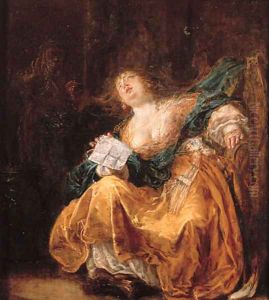Nicolaes Knupfer Paintings
Nicolaes Knupfer was a Dutch painter known for his small-scale, highly detailed history paintings and genre works. Born in Leipzig, Germany, in 1603, he moved to the Dutch Republic where he became active in the vibrant artistic community. Knupfer settled in Utrecht, which was a significant center for Northern Baroque painting and was influenced by the Utrecht Caravaggisti, a group of artists who were inspired by the dramatic chiaroscuro and theatricality of the Italian painter Caravaggio.
Knupfer likely trained with Abraham Bloemaert, a prominent Utrecht painter known for his history paintings and landscapes. This apprenticeship would have provided Knupfer with a solid foundation in the principles of composition, drawing, and the handling of color. Bloemaert's influence is evident in Knupfer's work, particularly in his attention to detail and the vibrant colors that typify his paintings.
Throughout his career, Knupfer developed a reputation for his small, finely executed paintings that often depicted complex biblical and mythological scenes. He was particularly adept at painting intricate figures and facial expressions, which brought his historical scenes to life. His works were also noted for their wit and the inclusion of moralizing themes, which were common in Dutch genre painting of the period. Knupfer's paintings were sought after by collectors and other artists, and he influenced a number of his contemporaries and followers.
Despite his success as an artist, there is relatively little biographical information available about Knupfer's life. He was not a member of the Utrecht guild of painters, which may explain the scarcity of records. However, his work was well-regarded during his lifetime, and he left behind a body of work that continues to be studied and appreciated for its detail, composition, and narrative quality.
Nicolaes Knupfer died in Utrecht in 1655. His works can be found in various museums and collections around the world, contributing to our understanding of Dutch Golden Age painting and the cultural milieu of 17th-century Utrecht. Despite his historical obscurity, Knupfer remains an important figure for his unique contributions to the art of his time.
